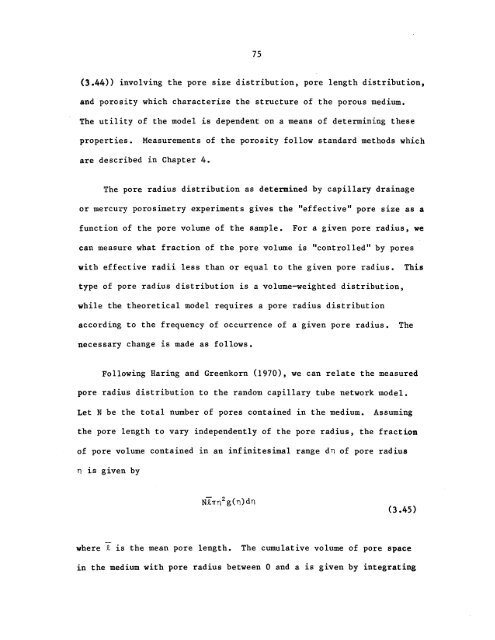longitudinal dispersion in nonuniform isotropic porous media
longitudinal dispersion in nonuniform isotropic porous media
longitudinal dispersion in nonuniform isotropic porous media
You also want an ePaper? Increase the reach of your titles
YUMPU automatically turns print PDFs into web optimized ePapers that Google loves.
75<br />
(3.44» <strong>in</strong>volv<strong>in</strong>g the pore size distribution, pore length distribution,<br />
and porosity which characterize the structure of the <strong>porous</strong> medium.<br />
The utility of the model is dependent on a means of determ<strong>in</strong><strong>in</strong>g these<br />
properties. Measurements of the porosity follow standard methods which<br />
are described <strong>in</strong> Chapter 4.<br />
The pore radius distribution as determ<strong>in</strong>ed by capillary dra<strong>in</strong>age<br />
or mercury porosimetry experiments gives the "effective" pore size as a<br />
function of the pore volume of the sample. For a given pore radius, we<br />
can measure what fraction of the pore volume is "controlled" by pores<br />
with effective radii less than or equal to the given pore radius. This<br />
type of pore radius distribution is a volume-weighted distribution,<br />
while the theoretical model requires a pore radius distribution<br />
accord<strong>in</strong>g to the frequency of occurrence of a given pore radius. The<br />
necessary change is made as follows.<br />
Follow<strong>in</strong>g Har<strong>in</strong>g and Greenkorn (1970), we can relate the measured<br />
pore radius distribution to the random capillary tube network model.<br />
Let N be the total number of pores conta<strong>in</strong>ed <strong>in</strong> the medium. Assum<strong>in</strong>g<br />
the pore length to vary <strong>in</strong>dependently of the pore radius, the fraction<br />
of pore volume conta<strong>in</strong>ed <strong>in</strong> an <strong>in</strong>f<strong>in</strong>itesimal range dn of pore radius<br />
n is given by<br />
(3.45 )<br />
where £ 1S the mean pore length. The cumulative volume of pore space<br />
<strong>in</strong> the medium with pore radius between 0 and a is given by <strong>in</strong>tegrat<strong>in</strong>g

















